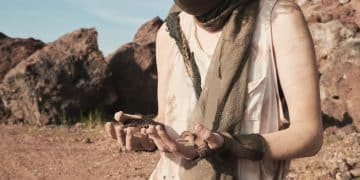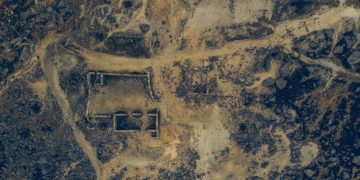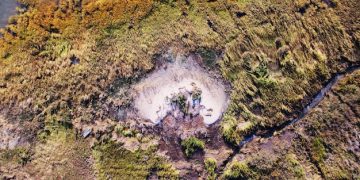The Ethics of Archaeological Excavation: Balancing Discovery and Cultural Heritage in the US
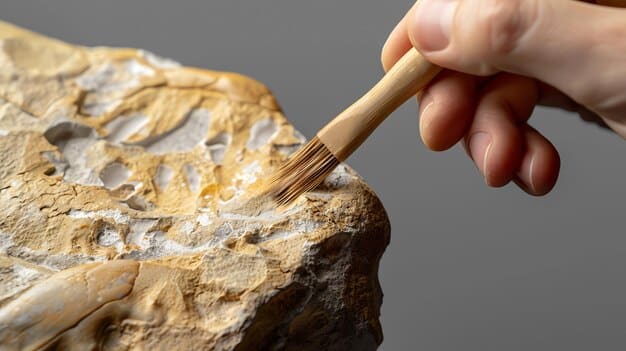
Achieving equilibrium in the ethics of archaeological excavation: balancing scientific discovery with respect for cultural heritage in the US demands continuous dialogue, legal frameworks, and community engagement to ensure responsible stewardship of the past.
In the intricate discipline of archaeology, few challenges are as profound and persistent as striking the delicate balance between the pursuit of scientific knowledge and the imperative to honor and protect cultural heritage. This tension forms the core of The Ethics of Archaeological Excavation: Balancing Scientific Discovery with Respect for Cultural Heritage in the US, a vital discourse that shapes how we unearth, interpret, and preserve the remnants of human history.
The Foundations of Archaeological Ethics in the US
Archaeological ethics in the United States have evolved significantly, moving from a primary focus on discovery to a more holistic approach that encompasses respect for descendant communities and the preservation of cultural integrity. This transformation reflects a broader societal recognition of indigenous rights and the intrinsic value of heritage beyond its scientific utility.
Early archaeology in the US, often driven by a quest for spectacular finds and a Eurocentric view of history, frequently overlooked or even disrespected the cultural connections of artifacts and sites. The shift towards ethical practice began to gain momentum in the mid-20th century, spurred by a growing awareness of the destructive impact of unchecked excavation and looting, particularly on Native American burial sites and sacred places.
Key Ethical Principles Guiding US Archaeology
Today, adherence to established ethical principles is paramount for any archaeologist working in the US. These principles are designed to ensure that archaeological endeavors are conducted responsibly, respectfully, and in a manner that benefits all stakeholders.
- Stewardship: Archaeologists act as stewards of the archaeological record, which is irreplaceable. This involves conserving artifacts and sites for future generations, preventing their destruction or commercial exploitation.
- Accountability: Researchers are accountable to the public, indigenous communities, and professional peers. This means transparent practices, open communication, and taking responsibility for the outcomes of their work.
- Commercialization Avoidance: Archaeological resources should not be treated as commodities. The sale or trade of artifacts derived from archaeological investigations is strongly condemned by professional organizations.
These principles are not mere guidelines; they form the bedrock of professional conduct within the field, reflecting a profound commitment to ethical practice. The historical context of US archaeology, marked by instances of colonial appropriation and disregard for indigenous sovereignty, makes these principles especially critical in fostering trust and collaboration with diverse cultural groups.
Furthermore, evolving ethical considerations compel archaeologists to engage more deeply with the communities whose histories they are studying. This includes involving them in the research process, incorporating their perspectives, and ensuring that archaeological interpretations are culturally sensitive and accurate. The journey towards truly ethical archaeology is ongoing, requiring constant reflection and adaptation to new challenges and understandings.
Navigating Legal Frameworks: NAGPRA and NHPA
In the United States, legislation plays a crucial role in shaping ethical archaeological practice, particularly concerning Native American heritage. The Native American Graves Protection and Repatriation Act (NAGPRA) of 1990 and the National Historic Preservation Act (NHPA) of 1966 are two foundational laws that have profoundly altered the landscape of archaeological excavation and cultural resource management.
NAGPRA is a landmark piece of legislation that addresses the rights of Native American lineal descendants, Indian tribes, and Native Hawaiian organizations to cultural items, including human remains, funerary objects, sacred objects, and objects of cultural patrimony. It mandates that federal agencies and museums inventory their collections and, upon request, repatriate these items to their rightful communities. This law directly confronts historical injustices, where Native American remains and cultural artifacts were often removed from graves and sacred sites without consent, then held in museum collections for study or display.
The implementation of NAGPRA has necessitated a fundamental shift in archaeological practice. Excavations on federal or tribal lands involving human remains or funerary objects now require extensive consultation with and consent from relevant Native American tribes. This has fostered a more collaborative approach, recognizing tribal sovereignty and their inherent right to manage their own heritage.
The National Historic Preservation Act (NHPA)
The National Historic Preservation Act (NHPA) preceded NAGPRA and established a national policy for the preservation of historic and archaeological sites. Section 106 of the NHPA is particularly significant; it requires federal agencies to consider the effects of their undertakings on historic properties. This means that before any federal project (such as highway construction or dam building) can proceed, an archaeological survey must be conducted to identify and evaluate any historic properties—including archaeological sites—that might be affected. If significant sites are found, measures must be taken to avoid, minimize, or mitigate adverse effects.
The NHPA has led to the development of Cultural Resource Management (CRM) archaeology, where the majority of archaeological work in the US is now conducted. CRM archaeologists work within the framework of development projects, ensuring compliance with federal preservation laws. This often involves conducting surveys, excavations, and monitoring activities to protect archaeological resources from destruction.
While both NAGPRA and NHPA are vital, they represent different facets of heritage protection. NAGPRA specifically addresses the repatriation and protection of Native American cultural items, grounding its authority in human rights and tribal sovereignty. NHPA, on the other hand, provides a broader framework for the identification, evaluation, and protection of all historic properties, regardless of their cultural affiliation, driven by the public interest in preserving historical understanding. The interplay between these laws requires archaeologists to navigate complex legal and ethical landscapes, balancing the immediate needs of development with the long-term preservation of the past.
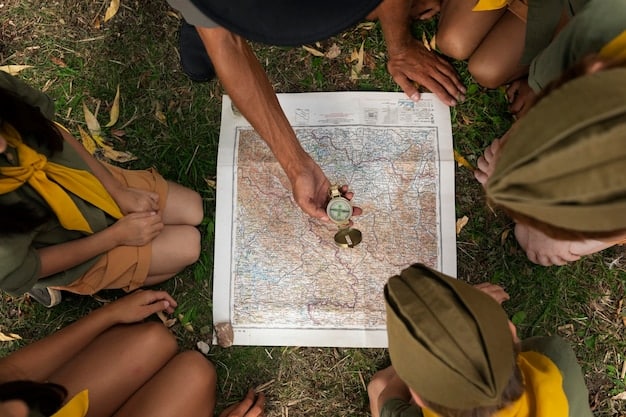
Community Engagement and Indigenous Perspectives
True ethical archaeological excavation in the US extends far beyond legal compliance; it necessitates meaningful and sustained engagement with descendant communities, especially Native American tribes. For too long, indigenous voices were marginalized or entirely absent from archaeological narratives, leading to interpretations that were often incomplete, biased, or disrespectful. Incorporating indigenous perspectives is not merely a courtesy but essential for enriching our understanding of the past and ensuring that archaeological practice is built on a foundation of mutual respect and collaboration.
Community engagement initiatives can take many forms, from informal consultations to formal partnerships throughout the entire research process. This includes involving tribal elders and cultural leaders in site identification, excavation planning, artifact analysis, interpretation, and ultimately, the dissemination of findings. When indigenous knowledge systems, oral traditions, and cultural protocols are integrated into archaeological practice, the resulting understanding of the past becomes richer and more nuanced. It corrects historical omissions and acknowledges the continuity of indigenous presence and connection to the land.
Benefits of Collaboration
The benefits of genuine collaboration are manifold, impacting both the scientific quality of archaeological work and its ethical standing.
- Enhanced Knowledge: Indigenous traditional ecological knowledge and oral histories often provide invaluable insights into site function, landscape use, and material culture that Western scientific methods alone might miss. This can lead to more accurate and holistic interpretations.
- Trust Building: By demonstrating respect and willingness to share power, archaeologists can build trust with communities that have historically been exploited or ignored. This trust is crucial for future research endeavors and for healing historical wounds.
- Meaningful Preservation: When communities are involved in decision-making, preservation efforts become more sustainable and meaningful. Sites and artifacts are protected not just for scientific study, but also for their enduring cultural and spiritual significance to living people.
Challenges to effective engagement include differing epistemologies (ways of knowing), historical mistrust, and resource disparities. Overcoming these requires patience, humility, and a genuine commitment to decolonizing archaeological practice. For example, archaeologists must be willing to cede control over certain aspects of research, particularly concerning sensitive or sacred sites, and respect requests for non-disclosure of specific information that holds spiritual significance rather than purely scientific value.
The goal is to move beyond mere consultation to true collaboration, where descendant communities are partners in the archaeological process from inception to completion. This reciprocal relationship ensures that archaeological discoveries contribute not only to academic knowledge but also to the cultural revitalization and self-determination of indigenous peoples, transforming the practice into a deeply ethical and socially responsible endeavor.
Challenges and Controversies in Modern Excavation
Despite significant advancements in ethical guidelines and legal frameworks, archaeological excavation in the US continues to face numerous challenges and controversies. These often stem from ongoing tensions between the academic imperative for discovery, the demands of cultural preservation, and the realities of modern development.
One persistent challenge revolves around the interpretation and curation of archaeological collections. Even after objects are excavated and studied, questions arise about their long-term stewardship. Who decides how artifacts are displayed, stored, or interpreted? For many indigenous communities, the very act of placing sacred objects in museum collections, even respectfully, can be seen as an interruption of their ongoing relationship with those items. Repatriation under NAGPRA is a step forward, but the vast majority of artifacts remain in institutional care, requiring archaeologists and institutions to navigate complex ethical waters regarding their access, use, and spiritual significance.
Another area of contention surfaces in large-scale infrastructure projects. While NHPA mandates archaeological surveys for federal undertakings, the pressure to complete projects on schedule and budget can sometimes result in hurried fieldwork or insufficient mitigation efforts. The adage “time is money” often conflicts with the slow, methodical pace required for thorough archaeological investigation. Balancing economic development with heritage protection remains a perpetual struggle, prompting debates about the adequacy of current laws and enforcement mechanisms.
Emerging Ethical Dilemmas
The advent of new technologies also presents novel ethical dilemmas. Non-invasive techniques like ground-penetrating radar (GPR) and LiDAR offer ways to explore sites without disturbing them, potentially reducing the need for destructive excavation. However, their use still requires careful consideration of access rights and data ownership, especially on sensitive tribal lands. Furthermore, the increasing use of DNA analysis on ancient human remains raises questions about consent from long-deceased individuals and their modern descendants, prompting debates about the limits of scientific inquiry versus personal and communal privacy.
- Private Land Excavations: A significant loophole exists for archaeological sites on private land, which are generally not subject to federal preservation laws unless federal funding or permits are involved. This leaves many valuable sites vulnerable to destruction by development or looting without any legal recourse for their protection.
- Looting and Illicit Trade: Despite legal protections, the illicit trade of artifacts remains a global problem, impacting sites in the US. Looping and commercial exploitation strip sites of their context, destroying invaluable information and depriving communities of their heritage.
- Climate Change Impacts: As climate change accelerates, coastal sites, thawing permafrost areas, and desert regions are experiencing rapid erosion and degradation, threatening to destroy archaeological records before they can be documented. This creates an urgency that sometimes clashes with the slower, consultative processes of ethical archaeology.
Addressing these challenges requires ongoing dialogue among archaeologists, government agencies, descendant communities, developers, and the public. It demands flexible approaches, dedicated funding for heritage preservation, and a continued commitment to developing innovative solutions that prioritize both scientific discovery and the profound respect for a shared, diverse human past.
Best Practices for Responsible Archaeological Excavation
To navigate the complex ethical terrain of archaeological excavation in the US, adoption of robust best practices is essential. These practices move beyond mere compliance with laws, aiming to foster truly responsible, respectful, and mutually beneficial archaeological work that upholds the integrity of both scientific inquiry and cultural heritage.
At the core of best practices is a commitment to minimally invasive excavation. This involves employing non-destructive survey methods whenever possible, such as remote sensing, surface surveys, and archival research, before considering any subsurface disturbance. When excavation is deemed necessary, it should be highly selective, targeted, and limited to what is absolutely required to answer specific research questions. The goal is always to preserve as much of the archaeological record in situ as possible, recognizing its finite and irreplaceable nature.
Prioritizing Documentation and Preservation
Meticulous documentation is another cornerstone of responsible archaeology. Every artifact, feature, and stratum unearthed must be precisely recorded, photographed, and mapped. This information provides the context that transforms an object into a data point, crucial for scientific analysis and interpretation. Without thorough documentation, an excavation becomes little more than treasure hunting, destroying information in the process.
- Conservation and Curation: Once excavated, artifacts must be properly conserved and curated in climate-controlled facilities, accessible for future research and study, and managed in consultation with descendant communities.
- Public Access and Dissemination: Research findings should be made accessible to the public in clear, engaging ways, beyond academic publications. This includes sharing information with descendant communities, local residents, and the broader public through exhibits, public lectures, and digital platforms.
- Long-Term Site Monitoring: For sites not fully excavated, developing long-term monitoring plans helps protect them from natural degradation, looting, or accidental damage. This ongoing stewardship ensures continued preservation.
Furthermore, responsible archaeology involves rigorous peer review of research proposals and findings. This ensures that methods are sound, interpretations are well-supported, and ethical considerations are adequately addressed. Professional archaeological organizations, such as the Society for American Archaeology (SAA) and the Register of Professional Archaeologists (RPA), play a vital role in setting and upholding these professional standards through their codes of ethics and conduct.
Training and education are also critical. Future generations of archaeologists must be thoroughly schooled not only in excavation techniques but also in cultural sensitivity, legal frameworks, and community engagement strategies. Continuous professional development ensures that practitioners remain abreast of evolving ethical considerations and best practices.
Ultimately, a commitment to responsible archaeological excavation means recognizing that the past does not belong solely to archaeologists but is a shared heritage. It requires humility, a willingness to listen, and a dedication to ensuring that scientific discovery serves a broader societal good, respectfully acknowledging the diverse profound meanings that cultural heritage holds for all people.
Case Studies: Successes and Setbacks in US Archaeology
Examining specific case studies from US archaeology offers valuable insights into how the ethical balance between scientific discovery and cultural heritage respect is, or sometimes is not, achieved. These examples highlight the complexities, triumphs, and ongoing challenges within the field.
One notable success story involves the collaboration between the Kennewick Man (Č’íxwapass) case. After years of legal battles over the disposition of ancient human remains, a turning point came in 2016 when new scientific evidence linked the remains to present-day Native American tribes. This led to the repatriation of Č’íxwapass to the Confederated Tribes of the Colville Reservation and four other Nez Perce, Umatilla, Yakama, and Wanapum tribes for reburial. This outcome, though long overdue, demonstrated the ultimate triumph of NAGPRA’s intent and the power of collaborative research in resolving contentious issues.
Another positive example is the ongoing relationship at the Bears Ears National Monument in Utah. Here, an inter-tribal coalition of Native American tribes played a central role in advocating for the monument’s designation and continues to be deeply involved in its management. Archaeologists working in this region often operate under memoranda of understanding with tribal nations, ensuring that research questions are developed jointly, and that cultural protocols are observed during fieldwork. This model exemplifies a shift towards co-management and shared authority over archaeological landscapes.
Illustrative Setbacks and Lessons Learned
Despite these successes, setbacks and complex ethical dilemmas persist. The construction of the Dakota Access Pipeline (DAPL) at Standing Rock Indian Reservation in North Dakota stands as a stark reminder of the challenges inherent in balancing development pressures with archaeological and cultural resource concerns. Despite significant protests by the Standing Rock Sioux Tribe and their allies, citing concerns about the pipeline’s route through sacred burial sites and traditional lands, federal permits were ultimately issued. Archaeological surveys were conducted, but the tribe argued they were inadequate and culturally insensitive. This case underscored the limitations of existing legal frameworks when economic and political interests clash forcefully with indigenous heritage rights, leading to perceived injustices and significant cultural loss.
Another challenging area involves the vast quantities of previously excavated, un-repatriated Native American skeletal remains and associated funerary objects held in museum collections. While NAGPRA dictates their repatriation, the process is incredibly slow due to underfunding, insufficient staff, and the sheer volume of items. Many institutions are working diligently to comply, but for some tribes, the pace is frustratingly slow, prolonging a sense of cultural grievance.
These case studies underscore several critical lessons. True ethical practice requires more than legal compliance; it demands active listening, empathy, and a willingness to adapt traditional archaeological methodologies to embrace indigenous ways of knowing and relating to the past. It also highlights the need for continued advocacy to strengthen legal protections and ensure that cultural heritage is not compromised by the relentless march of development. The path forward involves learning from both the successes that offer hope and the setbacks that demand renewed commitment to ethical principles.
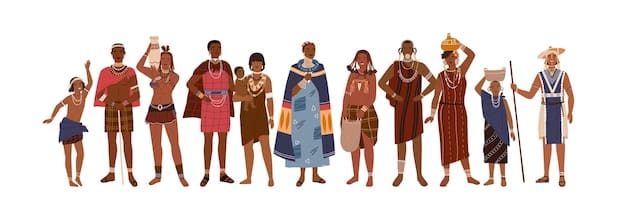
The Future of Ethical Archaeology
The field of archaeology in the US is continually evolving, driven by new technologies, revised legal interpretations, and a growing understanding of social justice. The future of ethical archaeological excavation will undoubtedly be shaped by these forces, moving towards practices that are more inclusive, sustainable, and respectful of diverse heritage values. This trajectory suggests a deeper integration of indigenous perspectives, a broader public engagement, and a more strategic application of archaeological research.
One emerging trend is the increasing focus on participatory archaeology, where descendant communities are not just consulted but are active participants and decision-makers throughout the research lifecycle. This co-creative approach moves away from the traditional model of archaeologists as sole authorities and embraces collaboration as a means to achieve richer, more ethically grounded interpretations of the past. Such partnerships often result in research questions that are both academically robust and culturally relevant, addressing concerns and priorities of those whose heritage is being investigated.
Technological advancements will continue to play a pivotal role. The widespread adoption of non-invasive techniques like LiDAR, drone mapping, and advanced geophysical surveys allows for extensive investigation of sites without the need for destructive excavation. This conservational approach minimizes disturbance to sacred sites and provides a more comprehensive landscape perspective, aligning scientific discovery with preservation goals. Furthermore, virtual reality (VR) and augmented reality (AR) offer potential for public engagement, allowing people to “explore” recreated archaeological sites and handle virtual artifacts, making heritage accessible while preserving the originals.
Key Shifts Anticipated
Several key shifts are anticipated to define the future of ethical archaeology in the US:
- Decolonization of Practice: Continued efforts to decolonize archaeology, recognizing and dismantling the legacy of colonial practices within the discipline itself. This involves critical self-reflection, valuing diverse epistemologies, and empowering indigenous voices.
- Enhanced Data Management: Developing robust, ethically sound digital data management systems that ensure long-term accessibility, security, and respectful stewardship of archaeological information, particularly concerning sensitive cultural data.
- Interdisciplinary Collaboration: Greater collaboration with other disciplines, including anthropology, environmental science, law, and indigenous studies, to address complex questions and develop holistic solutions for heritage management.
Public education and advocacy will remain crucial. As the importance of cultural heritage gains broader recognition, archaeologists have a responsibility to communicate their findings effectively and advocate for stronger protections against illicit trade, destructive development, and the impacts of climate change. Promoting archaeological literacy can foster a more informed and engaged citizenry, building a stronger constituency for responsible stewardship of the past.
In conclusion, the future of ethical archaeological excavation in the US is one of dynamic adaptation. It necessitates a continuous balancing act between the imperative to uncover and understand the past scientifically and the profound ethical obligation to respect and protect cultural heritage. By embracing collaboration, leveraging technology responsibly, and committing to ongoing self-reflection, archaeology can evolve into a more just, inclusive, and profound endeavor, ensuring that the stories of our ancestors are preserved and understood for generations to come, enriching all humanity.
| Key Point | Brief Description |
|---|---|
| ⚖️ Balancing Act | Archaeology in the US must reconcile scientific research with deep respect for cultural heritage and descendant communities. |
| 📜 Legal Frameworks | NAGPRA and NHPA are crucial US laws guiding ethical practices, especially concerning Native American cultural items and sites. |
| 🤝 Community First | Meaningful engagement and collaboration with descendant communities are vital for respectful and insightful archaeological work. |
| 🚀 Future Outlook | Future ethics lean towards participatory archaeology, non-invasive tech, and decolonizing practices for inclusive heritage studies. |
Frequently Asked Questions
▼
The core ethical challenge lies in harmonizing the scientific imperative to conduct research and unearth knowledge with the profound obligation to respect and preserve the cultural heritage of indigenous peoples and other descendant communities. This involves navigating sensitive issues like human remains, sacred artifacts, and tribal land rights, ensuring that discovery does not come at the expense of cultural integrity.
▼
NAGPRA (Native American Graves Protection and Repatriation Act) mandates the repatriation of Native American human remains, funerary objects, sacred objects, and objects of cultural patrimony to lineal descendants and tribes from federal agencies and museums. It requires extensive consultation with tribes before excavations on federal or tribal lands involving such items, shifting practice towards greater respect and collaboration with indigenous communities.
▼
Community engagement is crucial because it ensures that archaeological work is respectful, relevant, and accurate. Involving descendant communities, especially Native American tribes, in all stages—from planning to interpretation—allows for the incorporation of indigenous knowledge, oral traditions, and cultural protocols. This collaboration builds trust, enhances research quality, and ensures that heritage is preserved in a way that is meaningful to those connected to it.
▼
Modern archaeologists frequently grapple with conflicts arising from large-scale development projects, which can threaten archaeological sites. Other common controversies include the slow pace of NAGPRA repatriations, the illicit trade of artifacts from private lands where laws are weaker, and ethical considerations surrounding the use of new technologies like DNA analysis on ancient remains, balancing scientific progress with privacy and cultural sensitivity.
▼
Technology can significantly advance ethical archaeology by enabling less intrusive methods. Non-invasive techniques such as LiDAR, ground-penetrating radar, and drone mapping allow for extensive site investigation without destructive excavation, minimizing disturbance to sensitive areas. These tools help prioritize in situ preservation and can provide detailed data for research while reducing the ethical footprint of archaeological inquiry, supporting a conservation-first approach.
Conclusion
The journey towards fully ethical archaeological excavation in the US is a continuous and evolving process. As we have explored, it is not merely about uncovering the material vestiges of the past, but about doing so in a manner that honors the profound cultural, spiritual, and historical connections these sites and artifacts hold for descendant communities, particularly Native American tribes. Legislation like NAGPRA and NHPA have laid crucial groundwork, compelling archaeologists to engage more deeply with issues of repatriation, tribal sovereignty, and site preservation. However, true ethical practice extends beyond legal compliance, demanding genuine collaboration, mutual respect, and a willingness to integrate diverse ways of knowing into the archaeological process. The challenges are real, from balancing development pressures to addressing historical injustices, yet the commitment to responsible stewardship of the past remains steadfast. As the field looks to the future, embracing decolonization, leveraging non-invasive technologies, and fostering broader public engagement will be fundamental to ensuring that scientific discovery continues to enrich our understanding of human history while upholding the dignity and heritage of all.
